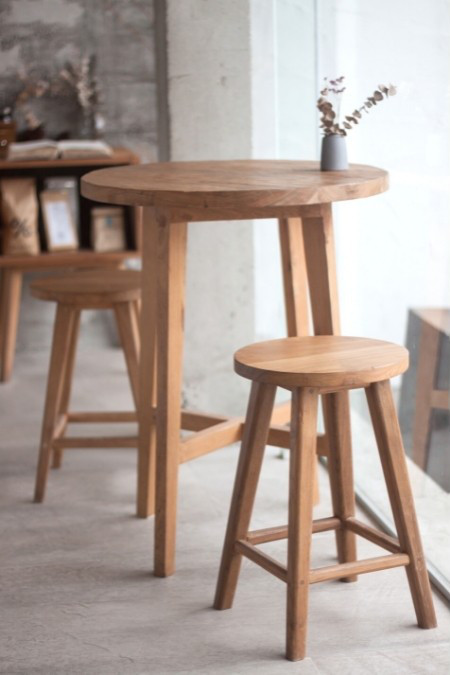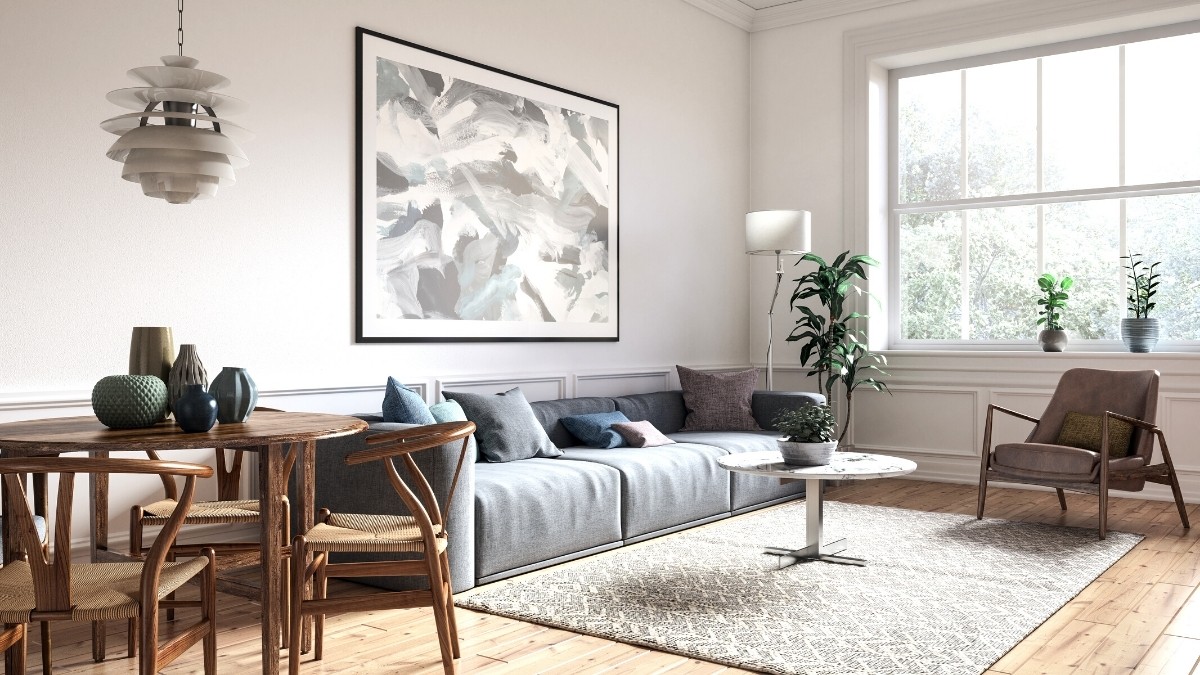Air pollution is a growing health concern for industrial society. But, while most of us are aware of outdoor pollutants like greenhouse gases, we give much less thought to indoor air quality. At the same time, we’re spending over 90% of our time indoors.
However, there is good news:
According to the U.S. Consumer Product Safety Commission, we can do a lot to manage the indoor air quality in our homes. From proper ventilation to only buying items that don’t release gas particles into the air, you can do plenty to improve air quality at home.
Choosing non-toxic furniture is one of the best ways to avoid toxins like formaldehyde, benzenes, and PFOA, all of which have been linked to cancer in humans. Plus, product safety is critical when you’re furnishing children’s rooms as they are more vulnerable to adverse effects caused by pollutants.
Ultimately, this is an issue that concerns end-users and manufacturers alike. The poisonous chemicals used in furniture production are a direct concern for worker health. At the same time, waste products pollute the area, threatening entire communities.
By choosing organic furniture, you’re not only creating a non-toxic home for your family but also supporting a better, safer environment for people involved in manufacture.
What is the New Furniture Smell?
Simply put, certain materials release volatile organic compounds (VOCs) into the air in our homes. It’s this subtle release of chemical fumes, which you then inhale, that we call off-gassing. Whenever you can smell a product, it’s off-gassing. The scent of fresh paint or new memory foam are both examples of this.
Even after the “new product” smell wears off, your furniture might be leaking toxic fumes into the air. Any chemical treatment can off-gas into the air, but paints, stains, and adhesives are often the worst offenders.
According to the Environmental Protection Agency, VOC concentrations are up to ten times higher in our homes than outside. Their adverse health effects can include:
- Eye and upper respiratory tract irritation
- Nervous system symptoms like headaches and coordination issues
- Nausea and vomiting
- Long-term liver, kidney, and central nervous system damage
- Some of these compounds have also been suspected or proven to cause cancer
Is there any way to avoid off-gassing?
Choosing certified non-toxic furniture is one place to start.
Products that meet the strictest standards for indoor air quality can receive the GREENGUARD and GREENGUARD Gold Certifications. The Gold certification meets even higher requirements set by California’s Department of Public Health (CDPH). It ensures items are safe for use in schools and healthcare facilities.
It’s also best to avoid used upholstered furniture. Dangerous chemicals in fabrics and foams can stay for years, slowly leaking into the air. The same is true for particle boards, which often contain large amounts of formaldehyde. Wood furniture like solid tables and chairs, on the other hand, are safe since the chemical treatments would have off-gassed already.
Toxic Furniture Materials You Should Avoid
Furniture manufacture involves multiple steps, with hazardous chemicals lurking at every stage of production. If you’re not an expert, it can be hard to navigate a world of so many possible toxins.
So which of the compounds are worth purging? Here is a list of chemicals to steer clear of:
Formaldehyde
Formaldehyde is a known human carcinogen found in pressed-wood products, glues, adhesives, insulation materials, fabrics, and paper products. The chemical vaporizes and can off-gas into indoor air for decades. Inhaling formaldehyde gas or vapor has been associated with leukemia, nasopharyngeal cancer, and possibly lung cancer.
Avoiding pressed-wood furniture made from plywood, particleboard, and fiberboard is the best way to prevent formaldehyde exposure in your home.
Steer clear of fabrics labeled as “wrinkle-free” or “stain-resistant” since they are also a significant source of formaldehyde.
Synthetic Fabrics and PVC ‘Leather’
Synthetic fabrics and faux leather are a significant source of VOCs and contain cancer-causing and endocrine-disrupting chemicals such as phthalates and BPA. Most are dyed with toxic dyes and then treated with flame retardants – both of which have been proven to be horrible for human health.
Moth-Resistant Wool
Moth repellents are another big offender when it comes to VOCs. Exposure to naphthalene can cause hemolytic anemia, liver and nervous system damage, cataracts, and retinal bleeding. The chemical is also linked to laryngeal and colorectal cancer.
Avoid pre-treated, moth-resistant wool and opt for natural moth repellents like lavender, bay leaf, cloves, rosemary, or thyme.
Flame Retardants
Flame retardants are a group of chemicals that are either flame-resistant or burn very slowly, increasing escape time in case of fire. They are very common in household environments. Unfortunately, most of these compounds also pose significant health risks. Young children are at risk from flame retardants because of hand-to-mouth contact with items such as upholstery and carpeting.
Polyurethane Foam
Your memory foam mattress might be the source of multiple health-harming chemicals. Polyurethane foam, the main ingredient, is a petroleum-derived material that releases a cocktail of toxic compounds into the air.
When an Atlanta lab analyzed memory foam mattresses, it found them to emit 61 different chemicals, some of them carcinogens like benzene. What is more, the flame retardants in your mattress release toxic VOCs, and additional chemical treatments also come with their risks.
Soy foam and bamboo sound like better options. They come from a renewable source, reduce your carbon footprint, and don’t release benzene into the air you breathe all night.
However, it’s often a tiny fraction of the filling, allowing companies to market their product as greener without actually doing much to improve environmental and health impacts. Soy foam is also non-biodegradable. It comes with a range of ecological concerns, such as GMO crops and pesticides. At the same time, pillows marketed as bamboo contain mostly synthetic materials like memory foam.
Non-Toxic and Sustainable Furniture Materials You Should Buy
Now that we covered what you don’t want in your furniture, here are the non-toxic alternatives to look for:
Natural Cushion Fill
Eco-friendly, non-toxic alternatives to polyurethane foam include:
- Natural rubber or latex comes from rubber tree sap. It’s 100% natural, breathable, and retains its shape for a long time. It’s also naturally hypoallergenic and resists dust mites without additional chemical treatments. Dunlop latex is one of the brand names you will see.
- A cotton filling also skips the synthetics, but it can attract mites and moths, so make sure to thoroughly clean and air out your cushions.
- Coconut fiber is a long-lasting upholstery filling that comes from natural, renewable sources and doesn’t emit dangerous chemicals.
- Kapok is a cotton-like fiber harvested from the Kapok tree in Asia and Indonesia. It’s a soft, silky material, perfect for filling cushions. As a bonus, organic kapok is easy to find.
- Animal-based alternatives include down and wool. Both of these can be excellent cushion fillings, provided they’re sustainably and ethically sourced.
Some cushion fill certificates to look for include CertiPUR-US (formaldehyde and phthalate-free, low VOC) and Global Organic Latex Standard (GOLS) for natural rubber materials (very popular for sleep products, so look for a GOLS mattress).
Toxin-Free Fabric Treatments
Chemical-treated fabrics are a significant source of indoor air pollution. To avoid toxin exposure, steer clear of PFAS coatings (frequently found in carpets and leather sofas and armchairs) and Scotch Guard treatments.
Natural materials like ethical wool, organic cotton, linen, or hemp are the best option. The GOTS certification is an excellent way to navigate the market as it comes with strict safety and environmental rules. Oeko–Tex ® certified fabrics are also a good option for your home textiles. Certification criteria weed out any toxic chemicals that appear in the production process.
Recycled Plastic Synthetics
Reducing the plastic in your home is the best way to avoid harmful chemicals. However, if you do end up buying synthetics, opt for those made from recycled materials. Not only are they better for the environment, but eco-conscious companies are less likely to use toxic compounds in the treatment process. Choose flame-retardant-free plastics as these chemicals are nearly always hazardous.

Sustainable Wood and Safe Particleboards
Solid wood furniture is beautiful and long-lasting, but it can be detrimental to the environment. Look for sustainably grown or recycled wood over conventional options. The Forest Stewardship Council (FSC) certification for forest management awards responsible forestry, while woods like oak, beech, birch, maple, linden, ash, poplar, pine, and aspen are less likely to come from illegal logging.
Bamboo furniture is another solid option, but make sure it’s also sustainably sourced. What is more, some bamboo treatments and stains can contain dangerous toxins, so look for the formaldehyde-free label. Steer clear of NAUF-certified items, though, as the program only covers one type of formaldehyde-containing chemicals.
If you choose items made with particleboard, make sure the company is transparent about the glues and solvents. Companies should train showroom floor employees to answer your questions. It’s best to skip the furniture-makers who avoid sharing information about their production process.
The CARB2 compliance certification is another way to orient yourself. It indicates minimal amounts of formaldehyde both in the end-product and during manufacture.
If you want to avoid toxins and save money, shop second hand for less expensive eco friendly furniture. Used solid wood furniture is an affordable and safe alternative. Just steer clear of anything with particle board, foam, and upholstery as these can off for many years.
Non-Toxic Paints, Stains, and Lacquers
Water-based stains and lacquers are hands-down the best choices for your furniture. They’re much less likely to contain dangerous chemicals and are gentler to the material. These paints don’t need a solvent, dramatically decreasing the VOCs they release and the indoor pollution they cause.
Conclusion
While we can all benefit from better indoor air quality, the information you need for better choices isn’t always available. Furniture manufacturers aren’t required to tell you about the materials they used. Small-time producers might also be unaware of the dangers of formaldehyde-laden glues, for example.
Still, if possible, choose local companies, ideally ones that also produce the furniture in your country. Local production makes materials much more traceable and chemical content easier to evaluate. Look for information on company websites or speak to staff about non-toxic components and finishes. No information on the matter is a major red flag.
Finally, certifications like GREENGUARD, CARB2 compliance, GOLS, or Oeko–Tex ® help you make healthier choices by doing the heavy lifting of third-party checking. Not all companies can afford them (small businesses usually won’t), but they’re a great way to spot conscious producers.
The journey toward a toxin-free and eco friendly home isn’t always straightforward. If you want to read more about shopping for sustainable furniture, we also wrote the essential guide.

